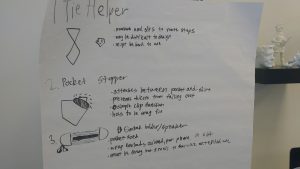This week, we met in our MakerLab for the first time in a little while. But we weren’t there to print anything just yet, at least not for the class. This session, we began the process of creating ideas for our class project. This isn’t always as easy as it sounds, however, as the first steps of design thinking can actually be the most difficult.
A major difficulty of problem-solving is deciding what problem to solve. If one already has an idea in mind, this can be easier, but for someone who simply has a broad scope of issues, it can be hard to narrow it down. Even with the three of us in my group, it took us quite sometime to find a problem that we thought would be worth fixing. Not all “problems” have solutions; some can just be improved. But just because they can, doesn’t mean they have to. It is perfectly fine to make small adjustments to existing designs or solutions, but we decided to create a whole other approach entirely for “more serious matters”. Being college students, we focused on problems that most young adults seem to have. We ended uncreating 3 relatively straightforward designs: a tie helper, pocket stopper, and earbud holder that could also be used as a speaker.

An important aspect in improving and finalizing a solution is getting feedback from others. Communicating one’s ideas to others allows them to get another perspective and prevent creator bias, it also is an opportunity to maybe receive criticism and suggestions for improvements. Something to be wary of in creating solutions is being to close-minded or focused on your own opinions of the issue rather than those of people who desire a solution to said problem. Even if the creator of such a solution is plagued by the same issue, people have different levels of impact from it. As Duncan Brennan’s blog “The Art of Engineering” states “[creating solutions] requires more lateral thinking and gathering information from a far wider variety of sources”. Problem-solvers sometimes get so absorbed in trying to find/create a fix that they forget the very purpose for doing so: to help others. We work to resolve these issues because they have personal meaning, or because we simply wish to make the world a better place for all.
Being a problem-solver can be an extraordinarily beneficial experience. One can grasp and gain the tools to assist those in need with solutions: no matter how simple or complex they may be. One can discover more about themselves; how they wish to benefit the world, what skills they possess or would like to improve. According to the Harvard Gazette, “One of the most exhilarating aspects of [an engineering/design curriculum]… is the opportunity to make stuff”. That “stuff” is both their solutions to problems and the benefits to the world that come of it.


Hi Brian,
I really enjoyed reading your post. I think your team came up with some great ideas to solve problems that college students may face. I can also see great possibility of realizing your idea using 3D printing. Like the articles suggested, the meanings of inventing is solving problems and make an impact. I think you and your team are definitely trying to solve the real life issues, and I look forward to seeing your demonstrations in the short future!